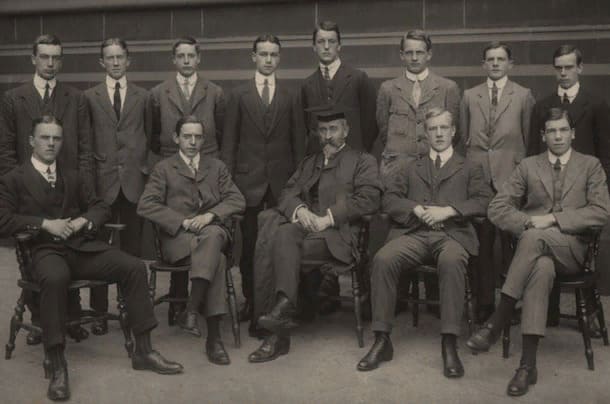Tolkien’s People: Edith Bratt, T.C.B.S. and The Inklings
It would be true to claim that, besides all the quests and adventures, John R R Tolkien wrote about relationships in the first place. About tight knots between souls of various creatures: elfs, humans, dwarfs, hobbits, after all. It is extremely easy to recall examples of such close, hearty connections: simply take members of the Fellowship of the Ring, Frodo and Sam, Aragorn and Arwen and all the others. Love and friendship were these crucial aspects of life which Tolkien himself was never deprived of. He cherished people around him and was considered to be the life of the party.

“The only real life is the one we share with others.’’
J.R.R. Tolkien
According to Carpenter (2002, p. 50) Tolkien had a “great capacity for making friends” and, as we have already covered, was happily married to his muse and love of his whole life for over half of the century. John was always surrounded by bright, like-minded people who pushed him to the new extremes of his talents and vice versa.
Of course, to enumerate and investigate the lives of all of Tolkien’s people would be impossible but we will step in the most important connections of his, get acquainted with the ones he loved and trace their reflections in the legendarium.
So, to cut a huge story short (just at the beginning, later it will still turn out to be overextended, as does every time), there were two fellowships in which Tolkien proudly participated and one lifelong love story that we are to study today.
We will start with T.C.B.S, stating for the Tea Club and Barrovian Society – a peer group of teen boys (Tolkien, Rob Gilson, Geoffrey Bache Smith, and Christopher Wiseman), who were equally passionate about art, mythology, languages and literature. All four attended King Edward’s School in Birmingham and spent much of their time together either studying or drinking tea during their private burning discussions in Barrow’s Stores (an elite shop nearby the school). This small secret society gave Tolkien his first taste of true belonging. He was encouraged by the unity and sophistication of their club and drew inspiration from their teatime conversations. Their fellowship consisted of true talents: Rob Gilson was an artist, Geoffrey Smith – a poet, Christopher Wiseman – a pianist and Tokien – a writer. The members of the T.C.B.S. shared their creations freely and were open for feedback from each other.
Young gentlemen kept in touch after graduation and while getting their degrees in Oxford (Tolkien and Bache Smith) and Cambridge (Gilson and Wiseman). Grievously, WWI began when all of them were still in university. One by one they were mobilised and by 1918, according to Tolkien himself, all but one of his friends were dead. Wiseman survived but came out of war a deeply traumatised person. Their connection with Tolkien was lost, yet, nevertheless, John’s son Christopher was named after Christopher Wiseman.
The T.C.B.S. was a real-life example of a true fellowship and there is no doubt in the significance of its role in Tolkien’s legendarium. What is genuinely vital to note here is that not only did the people and friendship itself become projected in the author’s writings, but also the tragic loss of it all in horrors of war and pain with which Tolkien had to live.
Many years later, somewhere at the beginning of 1930s, when life seemed a little more comfortable and stable, Tolkien was already a very solid professor of Anglo-Saxon at the University of Oxford (held the position from 1925 to 1945) and one of the principal members of the famous Inklings. So, what and who were these Inklings? The Inklings was an illustrious literary society whose members were united by a great shared interest for literature, philosophy, and religion. This group consisted only of the male participants, as it was common at that time, who were, by occupation, students and professors at Oxford but writers and poets, by passion. The original members of the club, except Tolkien, were C.S. Lewis, Owen Barfield, and Charles Williams. They were joined by other writers and scholars over the years, including Hugo Dyson and Nevill Coghill.
The name Inklings is, actually, a very versatile one: one side, the stem ‘ink’ serves as a reminder of the initial idea behind the society – sharing literary works in process (inky drafts) and discussing them. On the other hand, if we steep in etymology of the notion of ‘Inkling’, we can find out that the word came from Middle-English in the meaning of ‘hint’ or ‘suspicion’ which could be associated with the unfinished plotlines that served to be main topics of conversations.
The Inklings met regularly at Lewis's rooms at Magdalen College, Oxford, where they read aloud, critiqued and discussed each other's writings. They often discussed issues related to literature and theology, which had a deep influence on the works of each of the members. The Inklings had an immense influence on each other's writing. But most importantly, they were friends.
The close and enduring bond between the renowned trio of Tolkien, Lewis and Barfield was, perhaps, the most powerful and influential one in the history of the Inklings. Tolkien and Lewis were both masterful authors of works that encompassed fantasy and related genres, which proved to be a strong tightrope between hearts of two dreamers, while Barfield was an acclaimed philosopher. The three shared a sincere friendship, marked by mutual respect and admiration for each other's works and ideas. They were all devout Christians, and this faith was a fundamental influence on their creations. Tolkien and Lewis also held a shared passion for mythology and folklore, which were often discussed in the meetings of the Inklings. The Lord of the Rings and The Chronicles of Narnia, were greatly informed by the ideas of Barfield. Barfield's concepts on the intimate relationship between language, myth and imagination were prime elements of both Tolkien and Lewis' fantasy realms. Barfield also wrote several literary pieces of his own, most notably Poetic Diction and Saving the Appearances.
It is now clear that the Inklings aided Tolkien in finding those numerous sources of material and inspiration that were poured in the creation of his epic trilogy. And what is more, it was also a society of good like-minded friends, who paved the way to greatness together.
Finally, we are to draw on one person who connected all the periods and all the dots of Tolkien’s life and career together; who, probably, was the second human being who gave so much to Arda, and Middle-earth and every little bit that they consist of, that only Tolkien’s own input could outdo it.
While still in his school years Tolkien made an acquaintance with Edith Bratt – an orphan girl, who was three years older than him. They were sixteen and nineteen respectively. At that time Edith had just finished her musical studies and was on a crossroad in life. Their relationship gradually grew from a devoted friendship to a true love. However, Tolkien’s guardian Father Francis Morgan disapproved of the union due to the age gap and religious incompatibility (Edith was a protestant) and prohibited young Tolkien to be anyhow connected with miss Bratt till his own coming of age.
This event was a major heartbreak for Tolkien but he was certain in the strength of his feelings and patiently waited for his 21st birthday to contact Edith and reveal his love to her once again. Their marriage lasted for 55 years and is considered to have been an extremely happy and fruitful one.
As we have already covered in the first article, Tolkien depicted Edith in one of his most prominent heroines – Lúthien Tinúviel, an elven princess. It is believed that John got so inspired watching Edith dance in a forest for him that he created the beautiful love story about Lúthien and Beren, a mortal man, in whom Tolkien embodied himself.
Even though there is only one direct representation of Tolkien’s wife in his legendarium, according to the author himself, their children and notable scholars, Edith was John’s rock in daily life and in his whimsical writings. She was the one to whom he turned for support and inspiration. In The Silmarillion Tolkien wrote:
“I shal love thee, Lady, even unto death.”
This line is inscribed on their gravestone. Edith passed away at the age of 82 on 29th November 1971. Almost two years later, on 2nd September 1973 John R.R. Tolkien followed her. Today, Tolkiens’ love story is viewed as one of the most beloved and celebrated in every corner of the world.
There’s not much left for me to say on such personal topics of J.R.R. Tolkien’s life but I hope you’ve gained an opportunity to understand his nature and motifs of his artistic activity a little bit better.
Karima Lakekhal
References
- Zaleski P., Zaleski C. The Fellowship: The Literary Lives of the Inklings: JRR Tolkien, CS Lewis, Owen Barfield, Charles Williams. – Farrar, Straus and Giroux, 2015.
- Bratman D. The Inklings and Others: Tolkien and His Contemporaries // A Companion to JRR Tolkien. – 2014. – pp. 317-334.
- Foster M. Tolkien at Exeter College: How an Oxford undergraduate Created Middle-earth. – 2015.
- Garth J. Tolkien and the Great War: the Threshold of Middle-earth. – HMH, 2013.
- Fimi D. Linguistics, mythology and tea: Love, study, friendship and war: JRR Tolkien's early life //TLS. Times Literary Supplement. – 2019. – №. 6059. – pp. 22-23.
- Bunting N., Hamill-Keays S. JRR Tolkien's inspiration for Lúthien: the “gallant” Edith Bratt // Journal of Tolkien Research. – 2019. – Т. 8. – №. 1. – p. 9.
- Tolkien J.R.R. The Silmarillion. - 18 ed. - London: HarperCollins, 1991. - 365 p.


